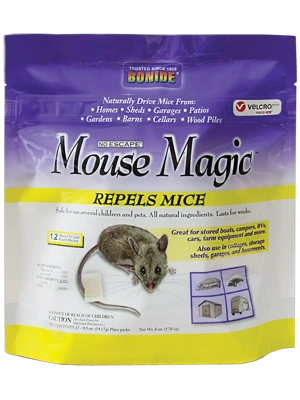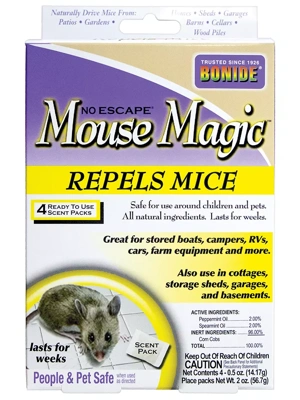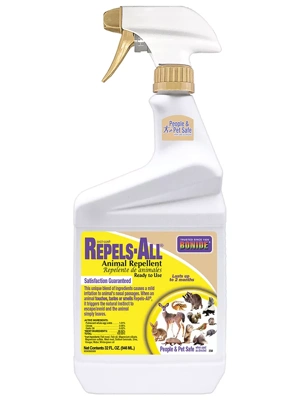Mouse in the House? No, Thank You!
Your house shouldn't be their home

Mice — just like humans — appreciate a cozy spot indoors in the winter. Autumn temperatures send them scurrying to shelter in warm corners behind water heaters and in cubbyholes under the sink. They don't know they are not welcome, and they make themselves at home.
Mice are enterprising, athletic, and persistent creatures, with astonishing reproductive rates. They live in garages, attics, closets, utility rooms, and porches; they build nests between the walls and in crawlspaces and basements. They are also a serious nuisance: mice contaminate food, chew through electrical wires, and even transmit diseases. Keeping them out of the house requires a sharp eye and effective defensive measures.
"Rodents really rule the world, and mice are everywhere," says Stephen M. Vantassel, a wildlife control expert at the University of Nebraska-Lincoln and editor of the National Wildlife Control Operators Association's newsletter. "But there is no reason for someone to have to tolerate a mouse problem." To mouse-proof your house, Vantassel says, "change the habitat to make it less mouse- friendly."
The house mouse (Mus musculus) will eat almost anything. Outdoors, mice eat seeds and grains. Indoors, they have more choices: they can find scraps of food on the floor, a bowl of nuts, crumbs behind a toaster.
Vantassel puts his annual mouse-proofing strategy into effect late every summer. If you feed the birds, birdseed should be stored in plastic or metal containers. Place rag bags, burlap, row covers and other landscape fabric into sturdy containers, too, to reduce access to nesting materials. Re-stacking a woodpile or removing garden brush heaps will also discourage mice.
Indoors, a clean house is the best defense, but it's hard to be clean enough to starve a mouse, which can live for several days on a single flake of cereal. Pet-food dishes are banquets for mice. "It's nutritionally balanced," Vantassel says, and mice thrive on it. Dry pet food should be stored in sealed containers.
Mice can squeeze through cracks just one-fourth of an inch wide; a dime-sized hole looks to them like an open door. To keep them out of the house, you have to seal all such gaps, working from the foundation to the roof.
"People underestimate the physical prowess of mice," Vantassel says. "They can leap vertically nine and a half inches, and they are outstanding climbers." Vantassel recommends closing gaps with copper mesh Stuf-fit or with Xcluder, a fabric woven with coarse stainless steel.
To get rid of an established mouse population, you have little choice but to kill the mice, Vantassel says. Cats are "very ineffective" helpers, he says.
Use snap traps, baited with peanut butter (smooth peanut butter is fine indoors; crunchy holds up better outdoors, Vantassel says) or caramel. Cheese "is a little lower down the list" of favored baits, he says. Mice gravitate toward warm spots to water heaters, gas stoves, and hot-water pipes. Place traps along walls near these appliances, with the bait side toward the wall. In an attached garage, set traps along the relatively warm wall next to the house. It's OK to reuse traps, but wear gloves to remove dead mice from traps and throw them away in a sealed plastic bag.
Once the mice are gone, keep them out by checking for openings and keeping food sources secure. Good housekeeping practices and a repellent will help, says Jim Wurz, president of Bonide, the company that makes Mouse Magic, a repellent made with peppermint and spearmint oils. "Mice just really hate it," Wurz says of the minty aroma, which smells like potpourri to humans.
Mouse Magic repellent comes in two formulations: one for indoors and one for outside. These products can be used around woodpiles or in campers, boats, or trailers where mice might seek shelter. It is all-natural and biodegradable; sachets (effective for about a month) can be placed behind appliances or under the sink.
Toxic baits should be a last resort, used only with caution and out of reach of children, pets, and other wildlife. "People need to realize that toxicants are dangerous," Vantassel says.
Always start with snap traps first, and be aggressive: use a dozen traps or more. "A mouse is an incredible critter," Vantassel says, but they don't belong in the house.
Last updated: 03/11/2024
Print this Article:
Related items
Get the Dirt
Stay up to date on new articles and advice. Please fill out the information below.




